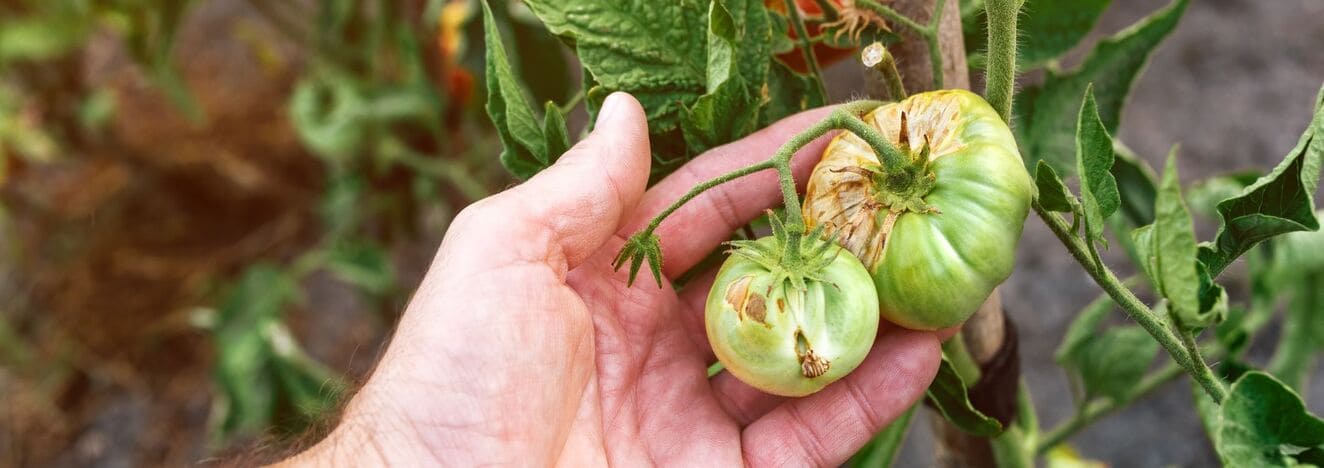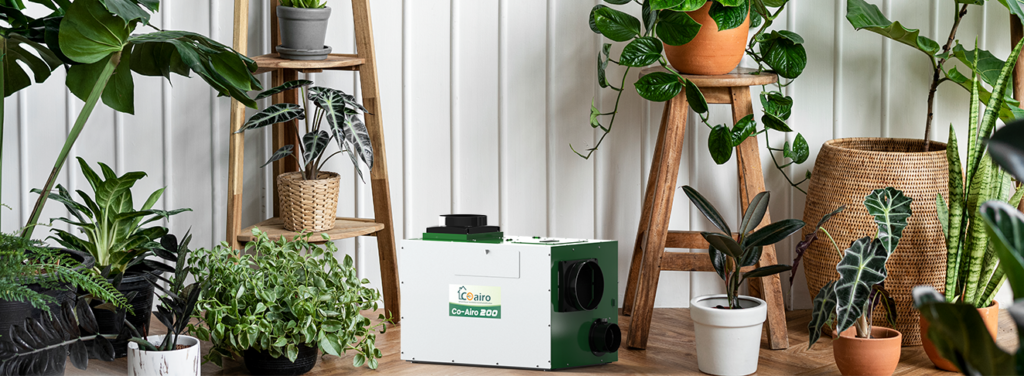Are you noticing a gray mold growing on your strawberries or flowers in your greenhouse or garden? This fungus is a common disease and you can see this infection developing on the plants everywhere. It can quickly ruin the crops if you do not manage it properly.
Scientists call this Botrytis. It attacks many crops like fruits, vegetables and cannabis. Recent research shows that it destroys at least 30% of rose production every year. It can be the reason for serious damage to plants’ health and yield.
Besides damaging the plants, is Botrytis Harmful to Humans as well? In this article, we will discuss all about this Botrytis fungal infection. You will also find simple tips to prevent it and protect your plants from infection.
What is Botrytis?
Botrytis is a common fungus that attacks plants. It is often called “gray mold. Cannabis growers name this as “bud rot“. Botrytis attacks over 200 different crops. It can be any ornamental shrub or tree and vegetables or flowers.
You will usually see it after heavy rain or during humid weather. In the first stage you will see a white growth on leaves or flowers. Then it turns into a fuzzy gray patch that looks like velvet. The wind easily spreads these spores to other nearby plants.
The mold enters through cuts or soft tissues. This infection spreads quickly. If you give time to grow more, the plant turns brown, dries out and dies. Botrytis cinerea is the most common type of this fungus which is responsible for this damage.
What Causes Botrytis?
If you don’t treat the infected plant debris and leave it, there is a 100% chance that gray mold will develop. Debris from past crops contains mycelium which can develop when there is sudden increase in temperature. This infection can grow during early spring.

Here are some causes you should aware of:
- High Humidity: Botrytis grows best when the air humidity is very high above 95%. Wet plant surfaces can grow the infection.
- Damaged Tissue: Healthy plants have a waxy skin that protects them. However, cuts, insect bites or aging leaves create an opening. The fungus can easily enter and attack damaged tissue.
- Infected Debris: If you leave dead leaves and rotting fruits on the ground it can be dangerous. The fungus lives in the debris until it moves to healthy crops.
- Wind and Rain: Spores are light and travel fast. A sudden breeze or splashing rain carries them from infected plants to healthy ones nearby.
- Poor Airflow: Crowded plants trap moisture. Without good air movement, leaves stay wet longer. This invites the mold to settle in.
Is Botrytis Harmful to Humans?
If you are a healthy person, Botrytis is not dangerous for you. It does not infect humans more than it infects plants. But some sensitive people can have uncomfortable symptoms from this fungus.
If you have asthma, seasonal allergies, or a weak immune system then don’t go around these infected plants. The spores travel through the air easily.
If you breathe around them it can trigger breathing them in can trigger coughing, wheezing or shortness of breath. If you have a pneumonitis hypersensitivity, there is a chance you will suffer from “Winegrower’s lung” which is a very rare allergic reaction of the respiratory system.
Is It Safe to Touch or Breathe Near Botrytis?
If you touch the gray fuzz, it does not poison you but it is also risky. Because the spores stick to your skin or clothes. When rubbing your eyes or touching your face you have a possibility of having a rash on the skin or itchiness.
It is also important that you do not inhale near these infected plants.. In a greenhouse or grow room, the concentration of spores can get very high. Workers in these environments often report headaches and chest tightness.
So it is best if you don’t go in these areas until the mold is gone.
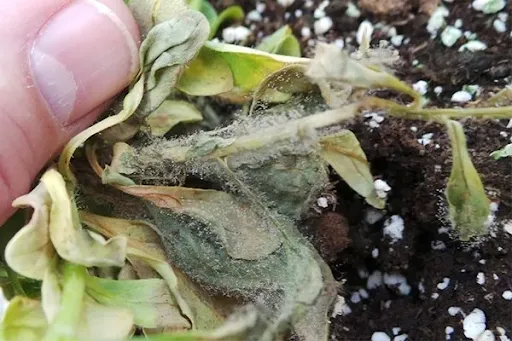
Common Signs and Symptoms of Botrytis
Watch for signs like:
- Gray, soft spots on fruits, flowers, stems and leaves
- A layer of gray fungal powder
- Fruits or plants that look rotten and dried out
- Hard black clumps made of fungal growth
- Flowers that look weak or wilted
You can easily mistake this fungus with other conditions such as Powdery Mildew. The main difference is the color and the texture. Powdery Mildew looks like dusting the white flour on dry leaves.
Botrytis is darker & gray and it makes the plant tissue soft and rotten. If you tap an infected leaf and see a cloud of gray dust fly up that is likely Botrytis spores.
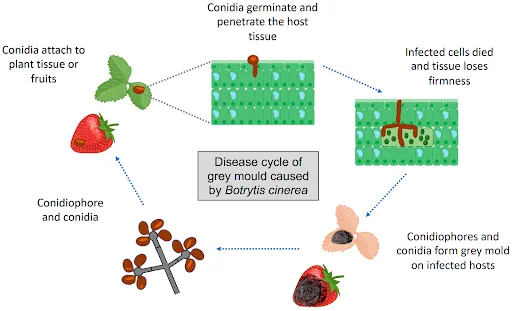
You should look carefully for symptoms in order to save your plants. These symptoms include gray mushy spots which appear on flowers, stems and leaves.
When the levels of humidity are high, gray fungus spores often form a coating over the plant. Plants and fruits start to dry out and look wrinkled hardened black fungal filaments which is located beneath the rotted areas
You may also notice gray mold on the top layer of the soil and in the thickest parts of the plant’s leaves and branches.
This fungus can develop first on wilted flowers and then spreads to other parts of the plant. It often appears in places where old, harvested or rotting fruits and vegetables are stored.
How to Prevent Botrytis? 5 Best Ways
Prevention measures for Botrytis are easier to follow rather than healing the affected plants. There is no need for harsh chemicals to keep your plants safe. You just need to manage the correct environment. Here are the 5 best ways to prevent Botrytis:
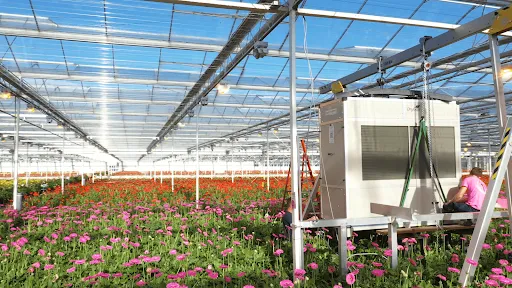
1. Control Humidity (Most Important Step)
The best and effective way to stop Botryllis is controlling humidity. This fungus cannot grow in dry air. So we recommend you to keep the relative humidity (RH) between 40% and 55%. In case the air remains excessively moist, the spores will come back to life and attack.
Plants also produce water vapor continuously in the indoor gardens. This makes the air heavy and damp. You can use Reliable Coairo Grow Room & Greenhouse Dehumidifiers. They pull excess water from the air and keep levels stable day and night. This prevents the dangerous humidity spikes that happen when the lights go off.
2. Improve Air Circulation
Stagnant air is a very good friend of Botrytis. When plants become overcrowded, the water vapor becomes trapped in-between the leaves. This forms tiny humid areas. These damp still places are the favorites of the Mold spores.
You must use fans 24 hours a day to maintain the air circulation within your space. Dead zones are avoided through proper placement of fans. This constant circulation assists in drying the leaves and mold does not settle in any place.

3. Keep Leaves and Buds Dry
In order to germinate and attack, Botrytis spores require standing water on the plant surface. Do not pour water on the top of the leaves. Rather, you should direct the water stream to the soil bed.
You should regularly water your garden in the morning. This timing enables the leaves to be all dry before sun sets. The moisture on the wet leaves may be condensed when the air cools down at night and this attracts the mold.
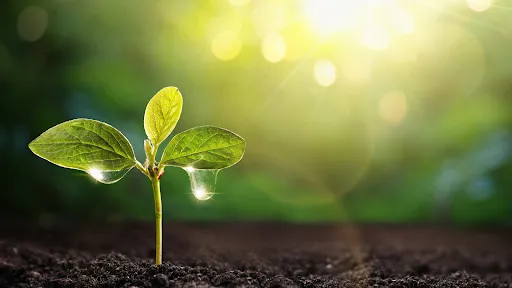
4. Clean Up Fallen Leaves and Dead Plant Tissue
Spores of Botrytis conceal and survive easily in the dead plant debris. Wilted leaves, faded flowers or rotten fruit should be taken off immediately. This debris forms a breeding ground to the fungus.
Do not forget to clean under benches as well as in thick canopies. Do not compost infected material. Clean up all the debris in your growing field so that the spores do not spread again.

5. Application of Proper Spacing When Planting
When plants are placed too close to each other they form a thick canopy. This prevents the evaporation of natural water vapor. The moisture that is trapped is rapidly built up around the leaves and buds.
Plants should be given sufficient space to grow. Proper spacing allows air to flow freely between plants. This is also useful in keeping the leaves and buds dry and also prevents the fungus growth by making it difficult.
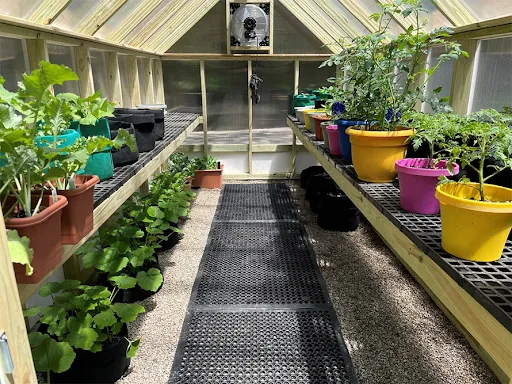
Plants Most Commonly Affected by Botrytis
Botrytis does not just damage one plant. It affects more than 200 species around the world. Growers of high value crops must watch out for it constantly. These are few of the crops which are usually most frequently attacked by this aggressive fungus.
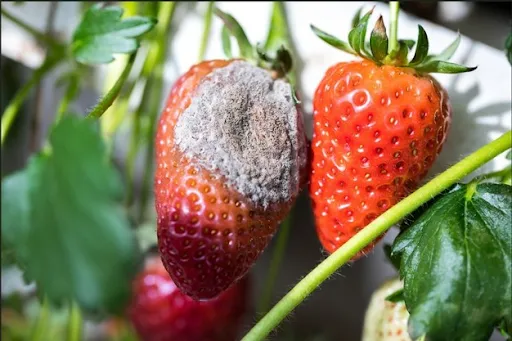
Botrytis on Cannabis (Bud Rot)
Cannabis is very sensitive to this fungus in which it is referred to as bud rot. The infection is transmitted quickly and kills the flower both internally and externally. Farmers have to apply special techniques to cover the dense buds.. Learn specific prevention tips for your cannabis plants here.
Botrytis on Roses
Roses are another favorite target of this infection. It is often suffering damage during transport and storage. The fungus ruins the market value of these beautiful blooms. It often attacks the flower stem and leaves brown patches. See how to protect your rose garden from gray mold here.
Botrytis on Strawberries
Every year Strawberry growers face huge losses because of Botrytis. This fungus makes this ripe fruit turn soft and mushy right after picking. This happens rapidly even after harvest. Find detailed strategies for keeping your strawberries healthy.
Botrytis on Tomatoes
Tomato plants can suffer severe stem and fruit damage from gray mold. The disease often enters through pruning wounds or old flower blossoms. This leads to soft & dark spots on the tomatoes themselves. Stop Botrytis from harming your tomato crop.
Conclusion
Botrytis is mainly a danger to your plants, not your general health. It causes serious crop loss quickly. Always remember it is cheap and easier to prevent, rather than to cure this dangerous infection.
Plants can be protected by managing the surroundings. The best thing you can do is control the level of moisture. Secure your investment today by exploring our powerful Dehumidifiers for Grow Room & Greenhouse.
